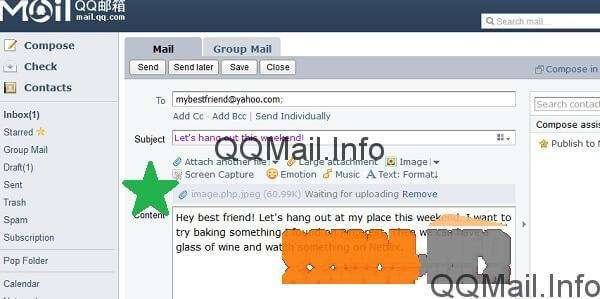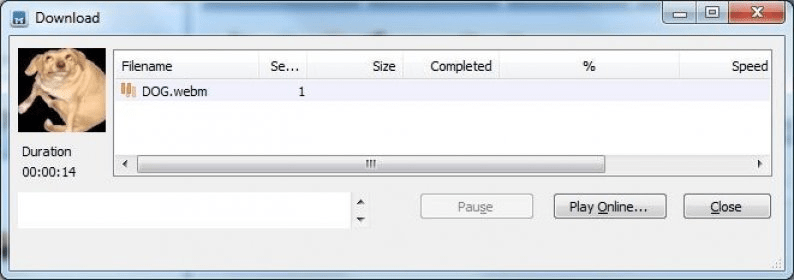Save your file to a cloud service and share a link. There are many cloud storage services to which you can upload and then share large files. Some popular cloud storage services include OneDrive, Dropbox, iCloud, and Google Drive. Once your file is stored in the cloud, you can include a link to the document in your email message. Where is QQ International Service Agreement? How to access my friend’s Qzone? Is there an English version of Qzone? Can I send an email to all my contacts? Can I link my QQ mail with other email providers? How to report inappropriate user behaviors?


Send Large File Free
Unfortunately WeChat has a file size limit set at 25MB. So how do we send large videos or other files to our friends through WeChat? Have you ever been frustrated by a similar message to below:
- How to send large files through Outlook. We invite you to use TitanFile’s Secure Send add-in to easily bypass the file size limit and send large files in all versions of Outlook and Office 365. On top of adding the capability to attach large files, TitanFile also encrypts emails to ensure that no unauthorized persons or parties have access.
- Here is how you can send large files to your friends in 3 easy steps: 1. Select Files - drag & drop up to 5 files to the highlighted area on the screen - you can remove them and select different files if needed 2. Fill out information - enter your e-mail address, it's required to manage your files - enter your recipients' e-mail addresses.
Today, China Channel will show you how to get round this limitation of send large files easily through WeChat using Weiyun (Micro Cloud 微云). Weiyun is a cloud storage service owned by Tencent (the parent company of WeChat). Like many of Tencent’s other platforms it works seamlessly with WeChat.
Weiyun is famous for offering an incredible 10 terabytes of free cloud storage. That’s far more space than many paid options such as Dropbox or Microsoft One Drive.
Attach Large File
Step by Step Guide
In this example we’ll show you how to take a large video file (250 megs roughly) on your desktop and using Weiyun share it so friends can watch or download the video easily through WeChat. First go to http://www.weiyun.com/ and log in with your WeChat account by scanning the QR code.
From the home screen simply upload the file using the blue button (添加 Add), see below:
It will start uploading, this may take time if it’s a large video file for example.
Once it’s done you can share several ways. There will be a link which you can simply copy & paste into a chat thread.
Also we recommend actually adding the Weiyun WeChat official account. This will make accessing all your cloud stored files much easier, anytime you want through WeChat. Go to ‘contacts’ then ‘official accounts’. Tap + in the corner and type ‘tencent_weiyun’ into the search field. You will bring up this account:
Alternatively scan the QR code below.
From the account you can easily access all your files
Selecting ‘All Files’ immediately brings up all the files that you’ve uploaded on Weiyun previously. Tap the blue button at the bottom and then share to either a chat or your moments.
Sharing in a chat will look like this:
Your friends can download for themselves through Weyun or just view, share or save the large video to their favorites directly in WeChat.
Weiyun also helps solve another problem: How to use just your phone to send non picture files to your friends through WeChat? Simply install Weiyun on your phone. Login with your WeChat ID and then upload the file from your phone to Weiyun. From there select the share icon and send the link to the file directly to your friend on WeChat.
I had to deal with a “huge” mail.que file this morning and thought of letting you know how to handle similar issues.So, here is the scenario
- Came to know about this issue only when SCOM alerted for a low disc space
- On one of the hub transport servers, the mail.que file reached to 148GB (unbelievable)
A lil about the mail.que file:
The mail.que file temporarily stores all emails before it is delivered to the target. It is an ESE database which means it is similar in architecture like an Exchange mailbox database, the edb file.
As per a TechNet article
A queue is a temporary holding location for messages that are waiting to enter the next stage of processing. Each queue represents a logical set of messages that a transport server processes in a specific order. Queues exist only on servers that have the Hub Transport server role or Edge Transport server role installed.

Let’s take a look at the other files residing in this location:
Trn.chk – Checkpoint file like E0x.chk in exchange
Trn.log – The transaction log file which is getting committed now. Similar to E00.log in exchange
Trntmp.log – The next transaction log file which is created in advance.

Trnnnn.log – Next transaction log file created when Trn.log reaches its maximum size.
Trnres00001.jrs – First reserve log file. Only used when the hard disk drive that contains the transaction log runs out of space to stop the queue database cleanly
Trnres00002.jrs – Second Reserve log file.
Temp.edb – Temp database used to verify database schema on start-up.
Back to the issue:
You need to know 2 important terms before we proceed since this issue could have caused due to a combination of both:
- PipelineTracingEnabled: This is used for troubleshooting purposes and is not enabled by default.
- MaxDumpsterSizePerStorageGroup: This is for Exchange 2007. The maximum size of the transport dumpster queue per storage group. This is a universal setting for all storage groups; you can’t set variable sizes for each storage group. The recommended size is 1.5 times the maximum message size that can be sent. For example, if the maximum size for messages is 10 megabytes (MB), you should configure the MaxDumpsterSizePerStorageGroup parameter with a value of 15 MB. Read more here
You can use the cmdlet: Get-TransportServer | fl to get these details.
In my case, tracing was enabled and the dumpster was specified to be 50GB.
Enough talking and lets delete it now
This is the suggested way to get rid of the old mail.que file and get a new one without any downtime. I proceed under the assumption that you have multiple hub transport servers to process emails so, no emails will be processed at the time of this change. This
should take about less than a minute. I will call the Hub transport server HUB01. Remember that steps 6-8 are very important and will ensure none loses emails
- Login to HUB01
- Open exchange management shell and run “Get-TransportServer ” HUB01″ |fl
- Here, look for PipelineTracingEnabled. This should be set to False. If not, run
Set-TransportServer HUB01 -PipelineTracingEnabled $False
MaxDumpsterSizePerStorageGroup is in MB’s and not GB’s
MaxDumpsterTime : 7.00:00:00
If not, run
Set-TransportConfig -MaxDumpsterSizePerStorageGroup <size> -MaxDumpsterTime <timespan>
- Now run “Get-Queue” and take a look at the count of messages in HUB01
- Goto services.msc and Pause the Microsoft Exchange Transport service
- Again, run “Get-Queue” and ensure all pending messages are “zeroed” out
- Once messages pending becomes zero, stop the Transport service
- Move the mail.que file and all others to a new folder in the same location
- Start the Transport service
- Take a look at the queue again
- You should see that messages would have started getting delivered
- Now you can backup or safely delete the old mail.que file
Ratish Nair
MVP Exchange
Team@ MSExchangeGuru
Large File Games
Keywords: Delete mail.que file, delete large mail.que file, mail.que file large in size, huge mail.que file in exchange, exchange 2007 mail.que file, mail.que file too big